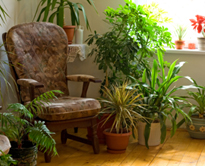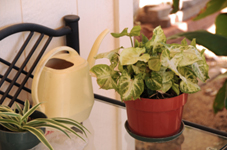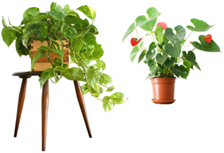Tropical Houseplant Care: Preserve Their Exotic Beauty
Providing the ideal lighting, water, and temperature requirements for your houseplants will ensure they maintain their exotic appearance in your home.
Houseplant care starts with selecting the right plants for your home.
Tips for Plant Selection
It’s easier to buy plants that will thrive in the existing environment of your home, instead of altering the environment of you home to accommodate the plants you buy.- Plants should look sturdy, clean, and healthy. Unhealthy
signs include yellow leaves, wilted foliage, and spindly growth.
- Thoroughly check plants for signs of insects and
disease.
- Plant requirements should match conditions in your home.
- Your lifestyle should allow you to care properly for the plants you select. If plants require a lot of watering, you, or someone you trust will need to check plants often.
Taking Your Plants Home
Extreme temperatures and direct sunlight can damage plants in a short period of time. Paying
attention to houseplant care when transporting plants prevents damage
when when you take the following precautions:
short period of time. Paying
attention to houseplant care when transporting plants prevents damage
when when you take the following precautions:
- Shade plants from direct sunlight.
- Be sure the temperature within the vehicle is not too hot
or cold.
- In extremely cold temperatures, protect plants by wrapping
them in newspaper and place them near a heater. If temperatures drop
below 50 degrees Fahrenheit, plants can be damaged beyond repair.
Lighting - Essential Consideration for Houseplant Care
Light provides the energy source plants need to manufacture
food (photosynthesis). It is essential for healthy, thriving plants.
The lighting requirements for houseplants typically fall into three
categories: low, medium, and high.
Low Light Plants
– Philodendrons, Ferns, and Ivy.
Medium Light Plants
– Spider Plants, Dracaenas, and Palms.
High Light Plants
– Hibiscus, Poinsettia, Kalanchoes.
Lighting requirements for tropical houseplants vary by species. Use
lighting requirements as your guideline for the selection and placement
of your plants.
Watering Indoor Plants
Watering houseplants properly, a basic element of houseplant
care, keeps them healthy and
vibrant. Both over-watering and under-watering can lead to poor plant
health, decline, and possibly death.
keeps them healthy and
vibrant. Both over-watering and under-watering can lead to poor plant
health, decline, and possibly death.
- Pots should have adequate drainage (usually a hole in the
bottom of the pot).
- Check moisture by sticking your finger into the soil up to
the first joint. If the soil is almost dry at your fingertip, it’s time
to water the plant.
- Water the plant until water runs out the bottom of the pot.
This will flush out excess salt build-up as well as ensure the bottom
of the pot receives sufficient water.
- Do not let the pot sit in standing water, this can cause
root damage.
Remember, the amount and frequency of watering depends on many
factors, such as species, size, location, and soil mix. Check your
plants regularly.
Temperature and Humidity
Temperature
– In general, tropical foliage houseplants thrive best in temperatures between 70-80
degrees Fahrenheit during the day, and 60-69 degrees Fahrenheit at
night. Tropical flowering plants will grow in the same daytime
temperature range; however ideal nighttime temperature is 55-60 degrees
Fahrenheit.
temperatures between 70-80
degrees Fahrenheit during the day, and 60-69 degrees Fahrenheit at
night. Tropical flowering plants will grow in the same daytime
temperature range; however ideal nighttime temperature is 55-60 degrees
Fahrenheit.
Humidity –
Most tropical houseplants require humidity to maintain health. You can
increase humidity by:
- Spraying plants with a fine mist of water.
- Placing pots on trays filled with pebbles and a thin layer
of water.
- Grouping plants close together.
Soil, Repotting, and Fertilization
Soil
– An ideal soil mix ensures good water drainage and root aeration. If
you decide to use commercial potting soil, be prepared to add sand or
perlite to ensure proper drainage and plant growth.
Repotting –
Spring is the time of new growth and an ideal time for repotting your
plants. Increase container size gradually (1-2” in diameter is usually
sufficient). Fast-growing plants may need to be repotted more often.
Fertilization
– Most houseplants can be fertilized every 3 to 6 months. You can water
your plants with a diluted fertilizer solution, or administer a
time-release fertilizer.





